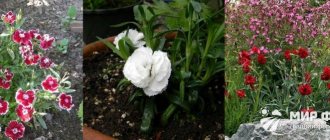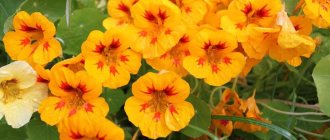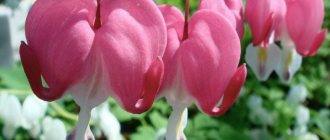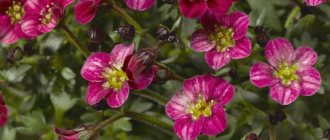What could be better than charming flowers grown by yourself? Today we will talk about perennial scabioses, which belong to the herbaceous or shrub genus. We will tell you how the process of growing them in open ground occurs. In addition, we will reveal some secrets of proper care for this plant, introduce you to its most popular varieties, and the presented photos of amazing scabiosis will demonstrate them in all their glory.
Scabiosa: varieties and varieties
This flower of the teasel family can reach a length of up to 1 m. Its stems are erect or branched, with pinnately divided leaves. Almost all species have inflorescences collected in dense bunches. This plant gravitates to a temperate climate. There are about 100 species and varieties of scabiosis, most of which are bred artificially.
Scabiosa is a very tender and very unpretentious plant.
The most famous types of scabiosis:
- Pigeon scabiosa. This mountain flower is very rare in nature. It loves moist soil, so it grows on the banks of streams or in meadows. Its stem branches slightly upward, and the leaves have an oblong shape. Flowering begins in July and lasts until the end of September.
Pigeon scabiosa - Caucasian scabiosa. This species amazes with the versatility of its color palette. Its representatives can have purple, lilac, pink, white tints and bloom for a very long time. The diameter of the flowers reaches 7 cm. Due to their exquisite and long-lasting beauty, these scabioses are often used in landscape design.
Caucasian scabiosa - Lace-leaved scabiosa. Also very attractive looking. These scabioses can have a charming silver-white or soft blue hue. The plant is propagated by sowing seeds.
Lace-leaved scabiosa
varieties of scabiosa are considered the most suitable for cultivation :
- Blauer Mond;
- Laherosa;
- Fairy;
- Schneebal.
Description and features
Scabiosa is a perennial plant that grows up to one meter in height; its trunk sometimes becomes woody at the base of the stem. The stems themselves can be simple or branched, strong, and erect.
The leaves are pinnate, divided or dissected. The flowers are located at the very end of the stem and are either in the shape of a ball or half a ball. They are painted in a variety of colors.
Dark, almost black, blue, cornflower blue. There are scarlet, pink, burgundy. Also white, pale yellow, cream. This flower is highly valued by beekeepers. Thanks to its strong aroma, it attracts bees to flower stalks rich in nectar.
Also, scabiosis is widely used in homeopathy. Moreover, the entire shrub is suitable for use, from the root to the flowers. It contains saponin, tannin, and alkaloid.
Infusions of this plant are used to treat headaches, abdominal pain, and colds. Even for dog and snake bites, lotions made from brewed herbs are used. From the root of scabiosis, decoctions are made for rinsing the mouth for stomatitis, sore throat, and toothache.
Lotions for scabies, pustular diseases, skin rashes. It also serves as an expectorant and diuretic. Young leaves of the flower are used in cooking and added to salads.
Scabiosa flowers are used to treat certain diseases.
Proper planting
Nothing will brighten up your garden like a light and colorful scabiosa. Planting and caring for this magnificent plant in open ground will not require any complex manipulations from you.
Plant scabiosa in fertile soil
An open sunny area is suitable for growing it. The soil should be chosen very carefully. Drained calcareous soil rich in various nutrients will be optimal for planting.
Attention! Do not plant scabiosa in very acidic soil, as it can cause the death of the plant.
Sowing seeds of perennial scabiosis in open ground at a shallow depth occurs in the spring (April). Keep a distance of about 30-45 cm, and 40 cm between the rows themselves. After sowing, the soil should be slightly moistened. Additionally, the seeds are covered with a layer of compost. Before planting seeds in open ground, gravel, humus, and manure can be added to the soil.
Growing
Watering and fertilizing
The flower needs to be watered regularly during drought; if the leaves hang limply, this means that the plant does not have enough moisture. Waterlogging must be avoided and the soil must be well drained. Especially immediately after planting a new bush, a lot of water is needed to nourish the roots. Fertilizers can be applied to perennials in the form of compost.
Scabiosa works very well as a gap filler, and takes little nutrients away from other plants.
In another article we described Edelweiss.
Reproduction
As a perennial plant, the scabiosa flower eventually grows to a decent size that can divide and thus multiply perfectly. To do this, the perennial plant should be dug up in the spring, divided with a sharp shovel or knife, and then planted again in a new or old place. This method also ensures that older plants develop better.
Annual varieties often reproduce by self-sowing. You can collect the seeds of mature flowers, store them dry in a dark place during the winter and sow them again next year. In addition, you can propagate especially beautiful plants from cuttings. To do this, shoots about 3 cm long are cut off in the spring. The lower leaves are removed, then the cuttings are placed in a pot with suitable soil and covered with foil. After 4-6 weeks, the first roots should form.
Tip: When collecting seeds, look for varieties if you want plants that vary in color.
Wintering
Perennial shrubs are quite hardy and do not need special protection. Only in very severe frosts is it advisable to cover them with thick foliage, sawdust or mulch. Anyone planting their scabiosa in a pot or bucket should also cover it with leaves or sawdust in winter, but these do not need to be taken to a protected location.
Optimal plant care
Caring for scabiosa is quite simple and will not be difficult for you. It is an absolutely unpretentious plant and easily tolerates cold and drought.
A condition for good growth and development of scabiosis will be the fulfillment of the basic rule of caring for them, namely: providing the plants with regular moderate watering. It is important to wait until the top ball of soil becomes dry. The soil around the plant should always be loose and free of weeds. Also, perennial scabioses can be replanted at any time, even during the flowering period.
Water scabiosa as the soil dries out
In order for this amazing plant to delight you with its flowering until late autumn, you need to periodically cut off the buds that have already bloomed. In addition, this procedure will help prevent scabiosa from self-seeding. Its seeds are collected already at full maturity in the autumn season.
Fertilizer and feeding of scabiosa
The cultivation of scabiosis must be accompanied by the application of various fertilizers. This is done when the root system of the plant is already fully developed. Most often, water-soluble liquid fertilizers are used. These perennial plants are fed at the rate of 20 g of fertilizer per 1 sq. m.
Scabiosis needs to be fed several times a season.
Scabioses respond well to fertilizing in the form of phosphorus-potassium fertilizers. This helps to increase the size of the buds and their brighter, more saturated flowering.
Reproduction of scabiosa
Plant propagation is carried out in three ways:
- sowing seeds;
- dividing the rhizome;
- seedlings.
Scabiosa seeds for further use are collected after flowering and stored in a ventilated, cool place.
Scabiosa seeds
Sowing seeds in open ground can be done in mid-spring, observing the necessary indentations. Don't forget that the soil needs to be watered. After 10-15 days, sprouts will begin to appear, and after 2-3 months the plant can begin to flower. When the scabioses get a little stronger, if necessary, they can be thinned out.
If it is still quite cold in your region in the spring, then seedlings . In March, scabiosa seeds are sown in a specially prepared container with soil. After this, the container is covered with polyethylene. Such containers should be stored in rooms with a temperature of about 15 degrees. Sprouts need to be ventilated daily. With the emergence of seedlings, the coating is removed from the container. After the leaves have germinated, the scabioses should be transplanted into separate pots.
Before planting in open ground, the plants are hardened off. For example, they are taken out into the open air for 1 hour every day. Planting takes place at the beginning of the summer season.
Scabiosa seedlings
Some types of perennial scabiosis are propagated by dividing the rhizomes . In the spring they are dug up and very carefully removed from the soil.
Advice. Be extremely careful when propagating scabiosa by division so as not to damage the plant’s rhizome, which is sensitive to mechanical stress.
Planting seeds in open ground
If the climate allows, spring is early and warm, you don’t have to waste time growing seedlings and sow seeds directly in the flower garden. It is better to do this in mid-April if there is no risk of night frosts.
Choice of location and lighting
Scabiosa can only grow well in light areas. Therefore, you need to choose a sunny place for sowing. It must be protected from strong winds. It is better that the site is elevated without nearby groundwater. Scabiosa does not like marshy soil. Therefore, it must be well equipped with a drainage system. This especially applies to perennials.
Landing rules
In order for scabiosa to grow well and bloom profusely, you need to prepare fertile, loose soil before sowing. It should be neutral acidity. In acidic soils the plant may die. It is recommended to dig up the area in the fall. 2 weeks before sowing, the area must be cleared of weeds and the soil loosened. Make shallow furrows at intervals of 35-40 cm and water. Place the seeds, keeping a distance of 5 cm between them. Sprinkle with soil. When the seedlings grow, they need to be thinned out, leaving the strongest specimens with intervals of 30 cm between each.
Diseases and pests
Fortunately, scabioses are immune to various pests and diseases. If you overdo it with watering, the roots will rot and fungus will appear, which can lead to complete death. Faced with such a problem, you urgently need to reduce the amount of watering the plant and treat it with fungicides.
Watering too much can cause rot to develop.
Scabioses also suffer from the appearance of powdery mildew. It causes a white coating on the leaves and gradual wilting of the plant. For treatment in this case, you can use special sulfur-based preparations.
Scabiosa: combination with other plants
The fantastic flowering of various varieties of scabiosis will not leave anyone indifferent. If you correctly combine them with other types of herbaceous perennials in pastel shades, the result will be a flowerbed of incredible beauty. Such floral combinations will decorate the most original exteriors with their presence and bring the most extraordinary landscape design ideas into reality.
Scabiosa in the flower garden
For example, scabioses in blue and white shades make a stunning combination with white seaside lobularia. Caucasian scabiosa of purple color can go well with various plants of a rural garden (paniculate phlox, Fassin's catnip, large-flowered nevus, etc.). You can use fragrant combinations of scabiosa with paniculate gypsophila, asters, irises or yellow yarrow.
Scabioses are also used to create beautiful holiday bouquets, vivid examples of which you can see in the photo.
Recommended varieties
Blue butterfly
A flower with a striking blue hue, 30 to 40 cm high.
Perfecta
It has large, violet-blue flowers and dark foliage, about 60-80 cm.
Ping pong
Golden yellow flowers, also suitable as dry interior decoration.
Scabiosa japonica
Perennial. It blooms from May to August with flat, densely filled blue or pink flowers.
Caucasian (Scabiosa caucasica)
Perennial. Height from 60 to 90 cm. Blooms from June to September with large cup-shaped flowers on densely standing stems. It has branched flower stems that are blue, blue-violet or white. The petals are slightly curled. The leaves are oblong, gray-green.
Can also be sown in early spring. It is a rather difficult plant to grow, as it does not tolerate frost or dampness. Goes well with aster, rose, sage, yarrow. Take cuttings from late spring to early summer or divide the rhizome in March-April for propagation.
Nutrient-rich, permeable and calcareous soil, rather dry. Must be protected from rain. Very sensitive to frost, so good winter protection is absolutely essential. Store in a warm place in pots. Originally from the Caucasus.
Velvet (Scabiosa atropurpurea)
Annual plant. Height 40-60 cm, width 15-25 cm. Blooms from spring to late summer. It has single white, blue or purple flowers up to 5 centimeters in diameter. Green leaves. Upright dense and well branched growth. Width from 15 to 25 cm Neutral or slightly alkaline soil, which should not be too nutritious.
"Clive Greaves"
A selection of seedlings originally grown by gardener James House, who ran a successful nursery near Bristol. House's family had previously christened the white uniform "Miss Willmott" after Ellen Willmott, who worked in the garden at Worley Place in Essex. They also developed their own seed variety, commonly known as Hausa hybrids, which are still available.
'Clive Greaves', released in 1929, outperformed the rest with its robust constitution and free flowering, and has never been improved upon. The real Clive Greaves was a young tradesman who worked at Hewitt's nursery in Solihull.
All varieties are very attractive to bees and butterflies.
Scabiosa columbaria
Our summer-blooming native, Scabiosa columbaria, is a compact plant with filigree foliage and wavy stems topped with tiny blue flowers.
But perhaps the best of all the small-flowered scabiosas is the sterile hybrid 'Butterfly Blue', which is sometimes mistakenly sold as 'Irish Perpetual'. It will bloom continuously from June until late autumn. This top-notch perennial is often sold in bright pink pots, which isn't exactly inspiring for the serious gardener.
Scabiosa plants also do not like hot and humid weather. Regardless of planting type, these flowers grow best in full sun and require well-draining, organic-rich soil. Adding compost, well-rotted manure or peat moss will help enrich the soil.
Flowers are usually grown from seed, although plants grown in containers may also be available. They can be started from seed indoors in early spring or sown directly into the garden after the threat of frost has passed. The seeds germinate within two weeks and can be individually grown in pots and transplanted into the garden by May.
Scabiosa in landscape design
These breathtaking plants are often used in modern landscape design, which is understandable. Scabioses, as well as their harmonious combinations with other flowers, create a stunning, beautiful picture that will decorate any area.
Scabiosa in a bouquet
Scabiosa is used to design stylish and popular alpine slides and mixed flower beds. Dwarf species of this plant in landscape design are planted along sidewalk paths, which also looks very impressive.
Botanical dossier
Scabiosa is a perennial herb or annual with a woody rhizome. The foliage of most species is slightly pubescent and partially divided into lobes, but there are also plants with simple, smooth leaves.
The flowers are small, tubular, collected in capitate inflorescences, in which the size of the outer flowers, located around the circumference of the saucer-shaped bract, much exceeds the size of the inner, very miniature flowers.
In several species the inflorescences are sessile, but in most they are crowned with a tall peduncle.
The color of the heads in natural species varies from lilac-blue, lilac and cream to purple, and in varieties the palette of inflorescence shades is much more extensive.
The plant blooms in the second half of summer and until mid or even late autumn.











